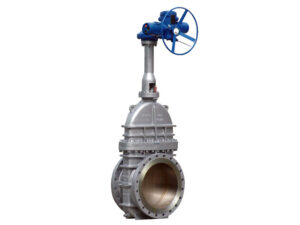The gate valve (GTV) is one of the most frequently used valve in piping systems and is classified as either “rising-stem” or “nonrising-stem” valves. The rising-stem gate valve has the stem attached to the gate, both gate and stem rise and lower together as the valve handwheel or actuator turns the stem. In the nonrising-stem gate valves the stem is threaded into the wedge, rising and lowering the wedge.
It is a multi turn valve which should be used for on and off service. If the valve is partially open as an attempt to throttle or control flow, turbulence from the stream could cause the wedge to vibrate and create a chattering noise. When fully opened, the gate valve creates minimal obstruction to the flow.
Gate valves control the process through the pipe with a gate. The gate might be wedge shaped or knife shaped, that slides up or down as the valve’s handwheel is turned. As the handwheel is rotated, the gate slides through the valve body to block or release the flow.
We in ITOK TEJARAT ARMAN are able to provide extensive variety of material and size with flexibility of selection for driving device (handle, bevel gear, electric, pneumatic, etc.) for all industries, from low to high temperature in different pressure of service.
- API Standards:
API Spec 6D, API Std 595, API Std 597, API Std 598, API Std 600, API Std 602, API Std 603, API Std 604, API Std 605. - ASME Standards:
ASME B16.5, ASME B16.10, ASME B16.20, ASME B16.25, ASME B16.34. - BSI Standards:
BS 1414, BS 2080, BS 5150, BS 5151, BS 5154, BS 5157,BS 5163, BS 5352. - MSS Standards:
MSS SP-42, MSS SP-45, MSS SP-61, MSS SP-70, MSS SP-80, MSS SP-81 ,MSS SP-84, MSS SP-86.

